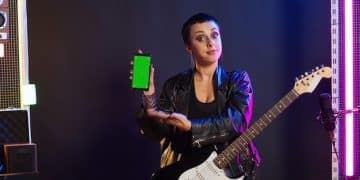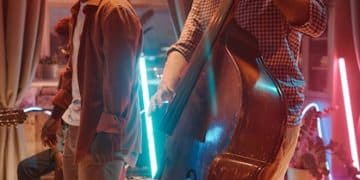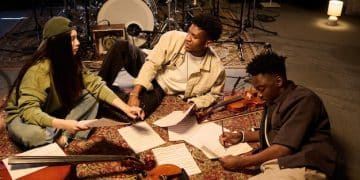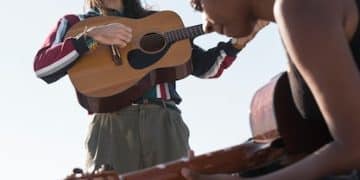Visuals’ Power: Compelling Album Art for Emerging Artists
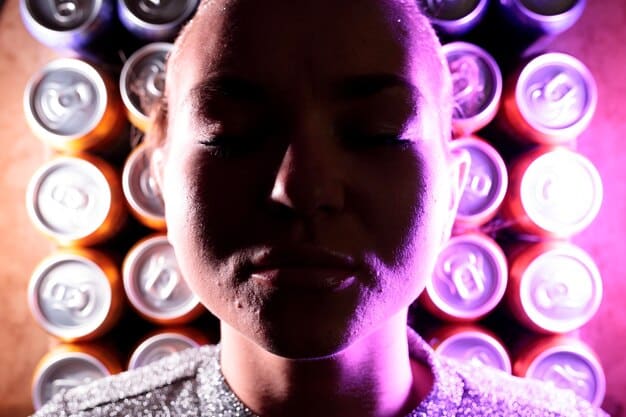
The visual identity of album art serves as a crucial first impression for emerging artists, captivating audiences and conveying musical essence before a single note is heard.
For any musician breaking into the competitive landscape, standing out is paramount. In an age dominated by streaming and digital discovery, the impact of a strong visual identity cannot be overstated. This is where The Power of Visuals: Creating Compelling Album Art for Emerging Artists truly shines, offering a critical competitive edge.
The Crucial First Impression: Why Album Art Matters
In the digital realm where music is often discovered through visual thumbnails, album art acts as the initial handshake between an artist and their potential audience. It’s more than just a cover; it’s a statement, a mood setter, and a critical piece of branding that can determine whether someone clicks play or scrolls past.
For emerging artists, this first visual encounter is particularly vital. Without the backing of major labels or extensive marketing budgets, their album art often becomes their most immediate and widespread form of advertising. It needs to convey not just the genre, but the personality, depth, and unique selling proposition of the artist’s sound.
Building a Visual Identity
An effective album cover is an extension of the music itself. It communicates the sonic landscape and emotional core of the tracks within. This visual identity is crucial for brand recognition and establishing a memorable presence in a crowded market.
- Instant Recognition: A distinctive cover helps listeners instantly identify an artist’s work across various platforms.
- Genre Communication: Visual cues can immediately signal the musical genre, attracting the right audience.
- Emotional Connection: Artwork can evoke feelings and set expectations, enhancing the listening experience.
Moreover, stellar album art serves as a conversation starter, generating buzz and encouraging shares on social media. It transforms a simple release into a multi-sensory experience, making the music more tangible and memorable.
Ultimately, investing in compelling album art is an investment in the artist’s overall narrative and professional perception, paving the way for deeper engagement and sustained growth within the industry.
Understanding Your Brand: The Foundation of Great Album Art
Before any design work begins, emerging artists must embark on a deep dive into their own brand identity. This isn’t just about choosing cool colors; it’s about defining the core essence of who they are as musicians and what message they want to convey. Without this foundational understanding, even a visually appealing design can fall flat, failing to truly resonate with the intended audience.
Consider your musical genre, lyrical themes, and overall artistic philosophy. Are you a soulful indie folk artist, a high-energy electronic producer, or a gritty hip-hop storyteller? Each genre carries its own visual language, and your album art should speak it fluently. Your personal aesthetic, values, and even aspirational image should inform every visual choice.
Asking the Right Questions
To crystallize your brand, ask yourself a series of probing questions. These insights will serve as your creative brief for the album art design process, whether you’re working with a professional designer or tackling it yourself.
- What emotions do I want my music to evoke? (Joy, introspection, defiance, transcendence?)
- Who is my target audience? (Age group, cultural background, interests?)
- What makes my sound unique? (Instrumentation, vocal style, lyrical content?)
- What is the story or concept behind this specific album/single? (Is there a narrative arc, a central theme?)
The answers to these questions will provide a clear direction, ensuring that the album art is not just aesthetically pleasing but also strategically aligned with your artistic vision. This alignment is what transforms a simple image into a powerful branding tool, helping to build a cohesive and recognizable presence in the intricate musical landscape.
Moreover, consistency in brand messaging across all platforms—from social media avatars to merchandise—amplifies the impact of your album art, creating a holistic and professional image.
Design Principles for Impactful Album Art
Creating truly impactful album art goes beyond mere aesthetics; it involves a thoughtful application of core design principles. These guidelines ensure that the visual not only catches the eye but also effectively communicates the artist’s message and connects with the audience on a deeper level. Understanding these principles empowers emerging artists to make informed design decisions, whether collaborating with a designer or embarking on a DIY endeavor.
Simplicity is often key. Overly complex designs can dilute the message and appear cluttered, especially when viewed as small thumbnails on streaming platforms. A strong focal point, clear typography, and a harmonious color palette contribute significantly to an impactful design.
Key Design Elements
Several elements combine to form a cohesive and compelling piece of album art. Each plays a role in conveying the overall mood and message.
- Color Palette: Colors evoke emotions and set the tone. Warm colors might convey energy, while cool tones suggest calm or melancholy.
- Typography: The chosen font should reflect the music’s genre and personality. A heavy metal band won’t use a whimsical script, for example.
- Imagery/Photography: Whether abstract, illustrative, or photographic, the main image must be compelling and relevant to the music.
- Layout and Composition: How elements are arranged affects visual flow and focal points, guiding the viewer’s eye.
Contrast, balance, and harmony are also paramount. Contrast ensures readability and visual interest, while balance creates stability, making the design feel complete. Harmony means all elements work together seamlessly, creating a unified whole. These principles guide the eye, creating a visual journey that complements the auditory one. By adhering to these well-established design tenets, emerging artists can craft album art that resonates powerfully and leaves a lasting impression.
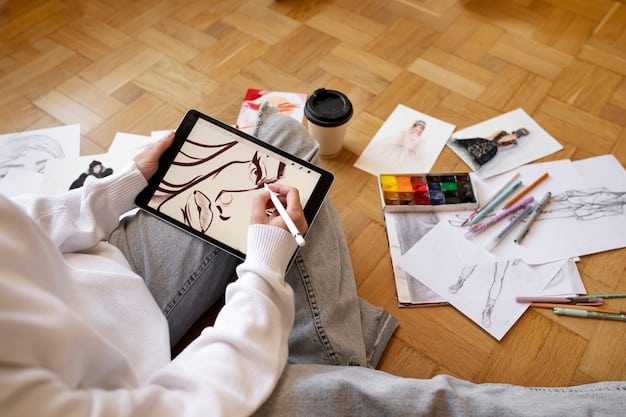
Tools and Resources for Emerging Artists
Crafting compelling album art no longer requires a hefty budget or extensive design experience. The digital age has democratized access to a plethora of tools and resources that empower emerging artists to create stunning visuals, often with minimal investment. From intuitive design software to extensive stock photo libraries and communities offering feedback, the possibilities are vast.
Understanding which tools best suit your skillset and budget is the first step. For artists with limited design background, user-friendly platforms simplify the creative process, allowing them to focus on their vision rather than steep learning curves. More experienced artists might opt for professional-grade software that offers greater control and customization.
Accessible Design Platforms
Numerous online platforms and software applications cater to different levels of design proficiency, making professional-looking album art attainable for everyone.
- Canva: Excellent for beginners, offering drag-and-drop functionality, numerous templates, and a vast library of stock images and fonts.
- Adobe Express (formerly Adobe Spark Post): Ideal for quick, social-media-friendly designs with professional templates and easy-to-use editing tools.
- GIMP (GNU Image Manipulation Program): A free, open-source alternative to Photoshop, offering powerful editing capabilities for those willing to learn its interface.
- Pixlr: A web-based photo editor that provides both simple and advanced editing options, accessible directly from your browser.
Beyond design tools, access to high-quality visual assets is crucial. Websites like Unsplash, Pexels, and Pixabay offer vast collections of free, high-resolution stock photography. For illustrations and vector art, Freepik and Vecteezy provide both free and premium options. Furthermore, creative communities on platforms like Behance and Dribbble can inspire and even connect artists with designers willing to collaborate or offer affordable services. The key is to leverage these resources strategically, ensuring that the visual output matches the artistic integrity of the music.
By effectively utilizing these accessible tools and resources, emerging artists can produce album art that stands toe-to-toe with professionally designed covers, capturing attention and reinforcing their musical brand in a highly visual world.
Collaborating with Designers: When and How
While DIY tools offer incredible flexibility, there comes a point where an emerging artist might consider collaborating with a professional designer. This decision often arises when the artist’s vision demands a level of sophistication, originality, or technical execution beyond their own capabilities. Recognizing this threshold is crucial for elevating the quality of their visual representation and truly maximizing The Power of Visuals: Creating Compelling Album Art for Emerging Artists.
Understanding when to seek professional help is as important as knowing how to do so effectively. Factors like budget, desired aesthetic complexity, and time constraints all play a role in this decision. A professional designer can bring fresh perspectives, technical prowess, and an understanding of visual trends that might be difficult for an artist to achieve on their own.
Finding the Right Designer
The process of finding a suitable designer requires careful consideration. It’s not just about portfolio; it’s about chemistry, communication style, and shared artistic sensibilities.
- Portfolio Review: Look for designers whose style aligns with your musical aesthetic and vision.
- Communication & Collaboration Style: Choose someone who communicates clearly and is open to feedback and iteration.
- Budget & Timeline: Be transparent about your budget, and ensure their timeline aligns with your release schedule.
- Recommendations: Seek referrals from fellow musicians or industry professionals.
Platforms like Fiverr, Upwork, and Behance are excellent starting points for discovering talented designers. Once you’ve identified potential candidates, prepare a clear and concise creative brief detailing your brand, the album’s concept, desired mood, and technical specifications. This brief acts as a roadmap, ensuring both parties are aligned from the outset, minimizing misunderstandings, and fostering a productive creative partnership. A strong brief, coupled with open communication, is the cornerstone of a successful collaboration that results in album art that truly resonates.
Legal and Technical Considerations for Album Art
Beyond the artistic and branding aspects, emerging artists must navigate a critical landscape of legal and technical considerations when creating and using album art. Overlooking these details can lead to significant issues, from copyright infringements to display problems on various platforms. Ensuring compliance and optimal presentation is vital for an artist’s professional integrity and widespread accessibility.
Copyright law is paramount. Artists must ensure that all elements used in their album art—images, fonts, illustrations—are either original creations, properly licensed, or fall under public domain. Unauthorized use can result in legal action, financial penalties, and removal from streaming services. Always verify the source and licensing terms of any external asset. When working with a photographer or illustrator, ensure your contract explicitly grants you the necessary usage rights for the artwork in question.
Technical Specifications for Digital Platforms
Modern album art primarily lives in the digital realm, so adhering to specific technical requirements set by streaming services and digital distributors is non-negotiable. These specifications ensure your artwork displays correctly across diverse devices and platforms.
- Resolution & Dimensions: Most platforms require square artwork, typically 3000×3000 pixels at 300 DPI for optimal high-resolution display.
- File Format: JPEG or PNG are common, with PNG often preferred for its lossless compression and support for transparency.
- Color Profile: RGB is standard for digital media; avoid CMYK, which is for print.
- Metadata: Ensure the artwork file is correctly named and embedded with relevant metadata (artist name, album title) for better organization.
Attention to these technicalities prevents pixelation, distortion, or rejection by distribution platforms. Furthermore, consider how your art will look as a tiny thumbnail on a phone screen versus a larger display. Simplicity and strong visual elements translate better across different scales. By meticulously addressing these legal and technical facets, emerging artists protect their creative work and ensure their compelling visuals reach their audience effectively and without impediment.
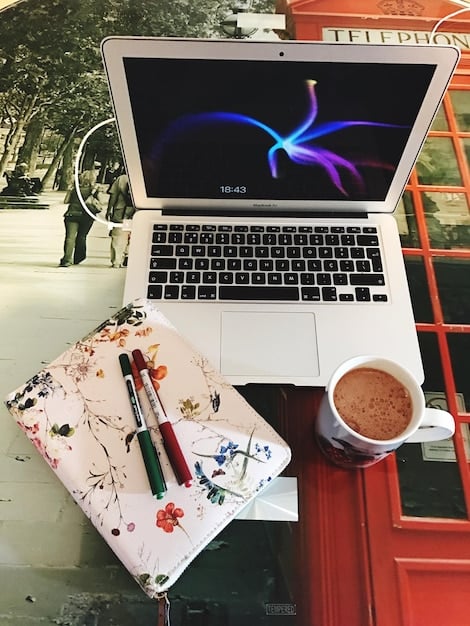
Promoting Your Music Through Visuals
Album art’s influence extends far beyond its initial release; it serves as a powerful promotional tool, enhancing an artist’s visibility and engagement across various platforms. For emerging artists, leveraging their compelling visuals strategically can significantly amplify their reach and help build a dedicated fan base. This active promotion transforms passive artwork into an dynamic asset within their marketing arsenal.
Incorporating album art into a broader visual marketing strategy is essential. It should be a recurring theme in your social media posts, website design, and promotional materials. Consistency in visual branding helps solidify your identity in the minds of your audience, making your content instantly recognizable and more memorable.
Maximizing Visual Impact
There are numerous creative ways to utilize your album art to promote your music and connect with listeners. Think beyond just posting the cover image; explore dynamic applications that enhance its appeal.
- Animated Album Art: Create short, engaging animations of your cover for Instagram Stories, TikTok, or YouTube shorts.
- Merchandise: Offer custom merchandise (t-shirts, stickers, posters) featuring your album art, turning fans into walking billboards.
- Social Media Campaigns: Design themed social media graphics that incorporate elements of your album art, hyping up releases or tour dates.
- Profile Pictures & Banners: Use your album art or derived visual elements for all your profile pictures and platform banners to maintain a cohesive brand.
Behind-the-scenes content showcasing the creation of your album art can also pique audience interest, offering a glimpse into your creative process. Engaging with fans by asking for their interpretations of the artwork or running polls on design elements fosters a sense of community and deeper investment. By proactively integrating your album art into every facet of your promotional efforts, emerging artists can ensure their compelling visuals work tirelessly to draw in new listeners and strengthen existing connections, solidifying their presence in the competitive music industry.
| Key Area | Brief Description |
|---|---|
| 🎨 First Impression | Album art is crucial for generating initial interest and communicating an artist’s brand and genre. |
| 💡 Brand Alignment | Art should reflect the artist’s unique identity, musical style, and emotional message. |
| 🛠️ Tools & Collaboration | Utilize design software or hire professionals for high-quality, impactful visuals. |
| ⚖️ Legal & Tech | Ensure copyright compliance and meet technical specifications for digital platforms. |
Frequently Asked Questions About Album Art
▼
Compelling album art significantly boosts discoverability by acting as a visual hook. In crowded streaming platforms, a striking image catches the eye, inviting clicks and listens. It also aids in quick genre identification and can make an artist’s profile more shareable on social media, expanding their organic reach.
▼
Budgets vary widely. For DIY, tools like Canva are free or low-cost. Hiring a professional designer can range from $100 to $1,000+ depending on experience and complexity. Many emerging artists start with affordable options and reinvest as their careers grow, balancing quality with financial capabilities.
▼
Yes, AI tools can generate unique artwork quickly. However, artists must carefully check usage rights and intellectual property regarding AI-generated images. Some platforms have ambiguous terms, and there’s debate over whether AI art is truly “original.” Always research the specific AI tool’s licensing and ensure exclusivity if needed.
▼
While overarching brand identity should remain consistent, specific album art changes with each release. For general visual branding (like social media banners), updates can happen periodically to reflect growth or new musical directions, perhaps every 1-2 years or with major career milestones.
▼
A common mistake is neglecting the art’s power as a first impression. Many artists use low-resolution images, have unreadable text, or create designs that don’t match their music’s genre or mood. Prioritizing clarity, genre alignment, and high quality, even on a budget, is crucial for making an impact.
Conclusion
In the dynamic landscape of the music industry, where digital platforms are the primary gateways to discovery, the visual presentation of an artist’s work holds immense power. For emerging talents, a compelling album cover isn’t merely an aesthetic choice; it’s a strategic imperative. It serves as a visual ambassador, captivating potential listeners, communicating artistic identity, and setting the emotional stage for the music within. By understanding their brand, applying sound design principles, and leveraging available tools—even collaborating with professionals when appropriate—artists can transform their album art from a mere formality into a potent marketing asset. Adhering to legal and technical standards solidifies their professional standing, while proactive visual promotion extends their reach far beyond the initial release. Ultimately, investing in the artistry and impact of album covers is a fundamental step toward building a memorable presence and achieving sustained success in the competitive journey of an emerging musician.
